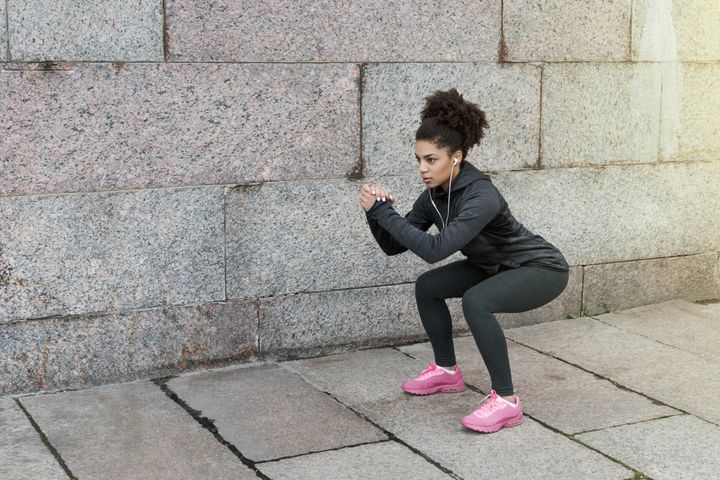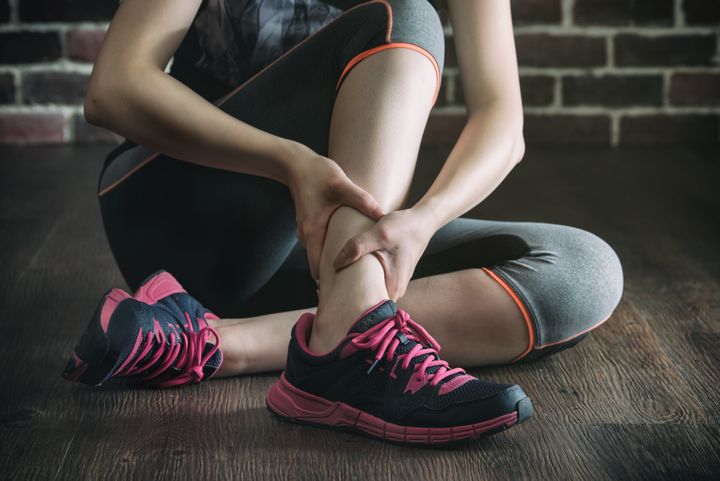Aching muscles following the days after your workout usually leaves you in two minds.
You’re either smug that you obviously worked hard enough for your muscles to ache, or you’re in so much pain that you refuse to do another squat for weeks.
But that muscle soreness and tightness you experience - usually up to 48 hours after exercise - has a proper term: delayed onset muscle soreness or ‘DOMS’.
If you’re suffering from DOMS, you’ll experience slight pain, stiffness, a drop in strength if you’re working out and - in severe cases - a slight bit of swelling.
But that’s nothing to worry about as Professor Phil Glasgow of Ulster University School of Sport and GB Rio 2016′s chief physiotherapy officer, explained.

What causes DOMS?
Glasgow said researchers have known for a long time that DOMS is caused by eccentric, lengthening muscle contractions.
So, if you take a simple bicep curl, the eccentric (or lengthening) contraction is the part of the exercise when you lower the weight back down again.
“You only get sore from the lowering down movement,” Glasgow explained. “Things like running down hills or lowering things - that’s what leaves you sore, it’s not the contraction.”
DOMS is also caused by the intensity of the workout, so the heavier the weight (and the longer the lengthening of the muscle), the more likely you’ll experience it.
If you do non-impact exercises, such as cycling, you won’t experience DOMS - probably just a slight muscle fatigue.
What is happening to our body and why is the pain delayed?
Changing your exercise routine - by working with a heavier weight or increasing the volume of our exercise (including going to the gym for the first time in a while) - will cause short-term damage to your muscles.
This muscle damage gets observed almost immediately after exercise and it sparks of a “cascade” of events within the muscle. And then it all gets a bit science-y.
“Certain chemicals cause a protest where muscles break down,” said Glasgow. “That releases substances that irritate nerve endings and cause pain. It’s a complex process that gives an immediate reduction in strength but a delayed pain and soreness usually 48 hours after.
“In that sense, there’s little you can do to prevent it from happening once the process has started.”
Through this process our body gets used to the new volume of exercise, and it becomes the new norm - establishing a new ‘base’ level of fitness.
“Our body is very good at adapting and responding to this delayed muscle soreness,” explained Glasgow.
“Most people going to the gym for the first time in a while will experience soreness the next few days, but the next time they go they won’t be as sore.”
Continue working out at that intensity and frequency and it’s unlikely you’ll get DOMS again.

Is getting DOMS ever a bad thing?
Glasgow said there’s been a lot of research into the various types of exercise, how it affects DOMS and how people managed it.
“DOMS is not a serious thing at all,” he said. “It’s short-lived and most people should be fine within a week - certainly 10 days.
“We recommend working on a level that gives you a little bit of DOMS so your body can adapt and gradually increase in strength in the most affective way.
“We then learn how to recruit muscle more effectively and our body learns the efficient way to do activity that causes less damage.”
“There’s little you can do to prevent it from happening once the process has started.”
- Professor Phil Glasgow
How can we treat DOMS?
The soreness in our muscles might not be a bad thing, but that doesn’t stop it from hurting. Glasgow advises against taking anti-inflammatory medication or ibuprofen because despite reducing the pain, they work to reduce the muscle’s ability to adapt.
Common treatment options include ice baths, compression clothes and staying active at a moderate level.
“Doing some form of activity is a positive thing,” said Glasgow. “Many studies have shown you won’t cause additional damage or excessive levels of soreness.
“There is no problem continuing to do exercise, but always just use the common moderate level rather than interval training.”
Some people are more prone to DOMs than others, and the greatest protection is a progressive programme of training.
Always work out responsibly and make sure you increase the intensity of your workouts gradually. If you’re still in pain after 10 days, seek medical help.